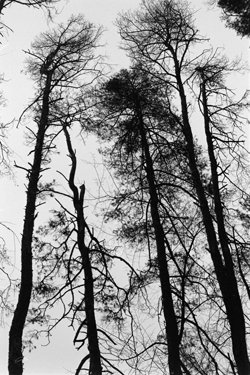The University Record, January 24, 2000 By Diane Brown
Facilities and Operations

A stand of Scotch pine trees on North Campus will be removed in mid-February. The trees, located in a small section of the corner wood lot on Fuller Road northwest of the Bonisteel Boulevard intersection, have pine wilt, according to U-M Forester Marvin Pettway.
“It saddens me to call for the removal of this pine grove, but it would be more saddening to delay our response and knowingly allow this disease to spread to other pine groves on our campus,” Pettway says. “Pine wilt has taken such a heavy toll on Scotch pine that extension specialists in several Midwest states no longer recommend planting this species as a landscape tree. The disease has a great ability to spread rapidly, especially in older Scotch pines. We know that insecticides and nematicides have proved impractical or ineffective.”
A public meeting to describe the tree removal process and subsequent efforts to manage soil erosion will be held at 7 p.m. Jan. 27 in the Boulevard Room, Pierpont Commons.
The tree removal, which will include tree tops and stumps, will take approximately three days. The wood will be chipped and transported to recyclers for use as fuel in power plants. Since the wood is diseased, it is not suitable for mulch or firewood.
Pine wilt is caused by a complex of organisms including pine wood nematode (Bursaphelenchus xylophilus), blue-stain fungi (Ophiostoma spp.), pine sawyer beetle (Monochamus spp.) and bark beetle (lps spp.). By the time the tree needles begin to turn a grayish-green, resin flow from the wood has ceased and the tree is dead or dying. The disease is usually spread through beetles in the spring.

